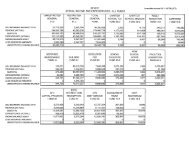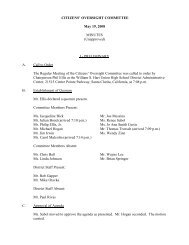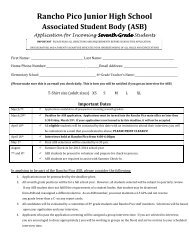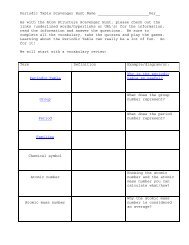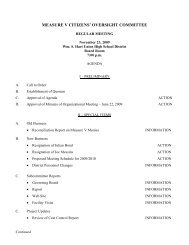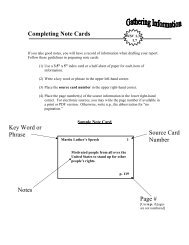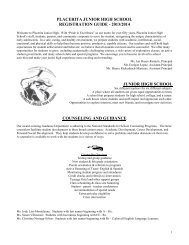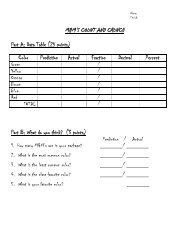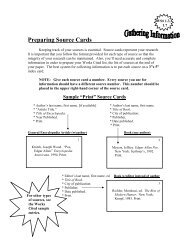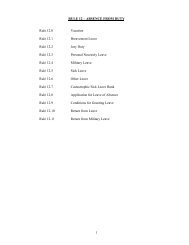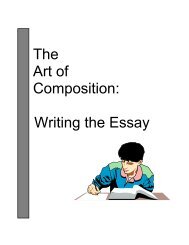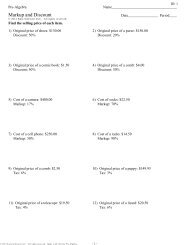Safe School Plan - William S. Hart Union High School District
Safe School Plan - William S. Hart Union High School District
Safe School Plan - William S. Hart Union High School District
You also want an ePaper? Increase the reach of your titles
YUMPU automatically turns print PDFs into web optimized ePapers that Google loves.
most to indoor pollutant levels and are of greatest concern. On average, reducing indoor air emissions as much as possible during smoke<br />
events may reduce indoor particulate levels by one quarter to one third or more, and levels of PAHs, VOCs and other pollutants by an even<br />
greater amount. These reductions can help compensate for the increased loading from the outdoor air.<br />
Masks: In order for a mask to provide protection during a smoke event, it must be able to filter very small particles (around 0.3 to 0.1<br />
microns) and it must fit, providing an airtight seal around the wearer’s face. Commonly available paper dust masks, which are designed to<br />
filter out larger particles such as dust created by sanding, typically offer little protection. The same is true for bandanas (wet or dry) and<br />
tissues held over the mouth and nose. In fact, they may actually be detrimental, giving the wearers a false sense of security and encouraging<br />
them to increase their physical activity and time outdoors.<br />
Surgical masks that trap smaller particles are also available, but these masks are designed to filter air coming out of the wearer’s mouth, and<br />
do not provide a good seal. As a result, these tend to be no better than dust masks. Some masks (technically called respirators, but they look<br />
more like paper masks) are good enough to filter out 95% of the particulate that is 0.3 microns and larger.<br />
Smoke particulate averages about 0.3 microns, so these masks will filter out a significant portion of the smoke if they are properly fit to the<br />
wearer’s face. These masks, which may include an exhale valve, do not require cartridge filters. They are marked with one of the following:<br />
“R95”, “N95” or “P95.” Soft masks with higher ratings (R, N or P 99 and R, N, or P100) are also available and will filter out even more<br />
particulate. Respirators with purple HEPA (pronounced hee-pa and stands for high efficiency particulate air) filters offer the highest<br />
protection, but may be less comfortable and slightly more expensive than the flexible masks. Again, unless there is an airtight seal over the<br />
wearers face, it will provide little protection. There are several drawbacks to recommending widespread mask use in an area affected by<br />
wildfire smoke. Most people won’t use the masks correctly and won’t understand the importance of having an airtight seal. For instance, it is<br />
impossible to get a good seal on individuals with beards. In addition, masks aren’t designed for use by the general population (including<br />
children.) As a result, the masks will provide little if any protection. In addition, they may give the wearers a false sense of protection, leading<br />
them to ignore other recommendations, like reducing physical activity, which could actually increase their exposure. Masks are<br />
uncomfortable (they are less uncomfortable when they are leaky – but then they do not provide protection.) They increase resistance to air<br />
flow. This makes breathing more difficult and leads to physiological stresses, such as increased respiratory and heart rates. Masks can also<br />
contribute to heat stress. Because of this, mask use by those with cardiopulmonary and respiratory diseases can be dangerous, and should only<br />
be done under a doctor’s supervision. Even healthy adults may find that the increased effort required for breathing makes it uncomfortable to<br />
wear a mask for more than short periods of time. Breathing resistance increases with respirator efficiency. Most healthy adults can use a 95%<br />
efficient respirator without undue breathing resistance. At higher efficiencies, breathing resistance will increase and the user will experience<br />
more discomfort. Another problem with masks is that most of them will not reduce CO. There are some instances where recommending<br />
mask use can be beneficial. For outdoor workers, or others that will be outside regardless of the smoke, masks (as long as they fit properly)<br />
can afford some protection. In cases where people are generally staying indoors, wearing a mask to go outside briefly might be useful. Masks<br />
can also be useful in conjunction with other methods of exposure reduction like staying indoors, reducing activity and using HEPA air<br />
cleaners, to reduce overall smoke exposure.<br />
Clean Air Shelters: In many places, staying inside may not adequately protect susceptible individuals. Many homes do not have air<br />
conditioning, and depend on open windows and doors for cooling. Other homes may be so leaky, that the pollution levels will soon equal that<br />
of outside air. During severe smoke events, clean air shelters can be designated to provide residents with a place to get out of the smoke.<br />
These can be located in large commercial buildings, educational facilities, shopping malls or anyplace with effective air conditioning and<br />
particle filtration.<br />
Closures: The decision to close or curtail business activities will depend upon predicted smoke levels, environmental and socioeconomic<br />
factors and other local conditions. It could be that exposure inside schools and businesses may be similar to or better than those in homes.<br />
Children’s physical activity may also be better controlled in schools than in homes, making school closings a poor choice. In many areas it<br />
will not be practical to close businesses and schools, but partial closures may be beneficial. Closures and cancellations can target specific<br />
groups (like the sensitive populations) or specific, high risk activities, like outdoor sporting events and practices. Curtailing outside activities<br />
can reduce exposures by encouraging people to stay inside and reduce physical activity. The decision to restrict industrial emissions should<br />
be based on the local air pollution situation and the emission characteristics of particular industries. Curtailment may not be beneficial if<br />
eliminating industrial emissions will not noticeably reduce the air pollution load.<br />
Evacuation: The most common call for evacuation during a wildfire is due to the direct threat of the fire instead of smoke. Leaving the area<br />
of thick smoke may be a good protective measure for members of sensitive groups, but it is often difficult to predict the duration, intensity<br />
and direction of smoke, making this an unattractive option to many people. For fires that go on for weeks, evacuation may not be possible for<br />
a large percentage of the population.<br />
* Coefield, John and Cyra Cain. 2001. Forest Fire Smoke Categories. Montana Department of Environmental Quality, PO Box 200901,<br />
Helena, MT 59620.<br />
70




